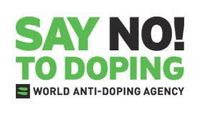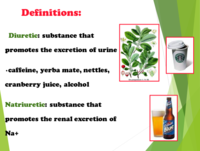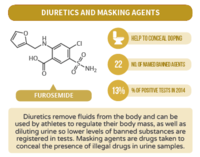Do you know?
A substance or method shall also be included on the Prohibited List if WADA determines there is medical or other scientific evidence, pharmacological effect or experience that the substance or method has the potential to mask the Use of other Prohibited Substances or Prohibited Methods.
WADA’s determination of the Prohibited Substances and Prohibited Methods that will be included on the Prohibited List. The classification of substances into categories on the Prohibited List and the classification of a substance as prohibited at all times or In-Competition only. Is final and shall not be subject to challenge by an Athlete or other Person based on an argument that the substance or method was not a masking agent or did not have the potential to enhance performance, represent a health risk or violate the spirit of sport.
Here are some facts about Diuretics and Masking agents.
Diuretics help rid your body of salt (sodium) and water.Most work by making your kidneys release more sodium into your urine. The sodium then takes water with it from your blood. That decreases the amount of fluid flowing through your blood vessels, which reduces pressure on your vessel walls.
Diuretics and masking agents (WADA Prohibited List, S5) are prohibited all the time The detection in an Athlete’s Sample at all times or In-Competition, as applicable, of any quantity of the following substances subject to threshold limits: formoterol, salbutamol, cathine, ephedrine, methylephedrine and pseudoephedrine, in conjunction with a diuretic or masking agent, will be considered as an Adverse Analytical Finding (AAF) unless the Athlete has an approved Therapeutic Use Exemption (TUE) for that substance in addition to the one granted for the diuretic or masking agent.
A diuretic is any substance that promotes diuresis, the increased production of urine.This includes forced diuresis. There are several categories of diuretics. All diuretics increase the excretion of water from bodies, although each class does so in a distinct way. Alternatively, an antidiuretic, such as vasopressin (antidiuretic hormone), is an agent or drug, which reduces the excretion of water in urine.
In medicine, diuretics are used to treat heart failure, liver cirrhosis, hypertension, influenza, water poisoning, and certain kidney diseases. Some diuretics, such as acetazolamide, help to make the urine more alkaline and are helpful in increasing excretion of substances such as aspirin in cases of overdose or poisoning. Diuretics are sometimes abused by people with an eating disorder, especially people with bulimia nervosa, with the goal of losing weight.
There are three types of diuretics: thiazide, loop and potassium sparing. Each type affects a different part of your kidneys and may have different uses, side effects and precautions.
The following diuretics and masking agents are prohibited, as are other substances with a similar chemical structure or similar biological effect(s). Including, but not limited to:
1. Desmopressin, probenecid; plasma expanders, E.g. intravenous administration of albumin, dextran, hydroxyethyl starch and mannitol.
2. Acetazolamide; amiloride; bumetanide; canrenone; chlortalidone; etacrynic acid; furosemide; indapamide; metolazone; spironolactone; thiazides, e.g. bendroflumethiazide, chlorothiazide and hydrochlorothiazide,triamterene and vaptans, e.g. tolvaptan.
3. Drospirenone, pamabrom, and ophthalmic use of carbonic anhydrase inhibitors (e.g. dorzolamide, brinzolamide)
4. Local administration of felypressin in dental anaesthesia.
The detection in an Athlete’s Sample at all times or In-Competition, as applicable, of any quantity of the following substances subject to threshold limits: formoterol, salbutamol, cathine, ephedrine, methylephedrine and pseudoephedrine, in conjunction with a diuretic or masking agent, will be considered as an Adverse Analytical Finding (AAF) unless the Athlete has an approved Therapeutic Use Exemption (TUE) for that substance in addition to the one granted for the diuretic or masking agent.
Do you think it is fare that athletes can be tested anytime and anywhere? Why? Why not?
Testing is done to ensure that the rights of the clean athletes are preserved. Athletes are tested anytime and anywhere to add to the element of surprise. If the athlete knows he/she could cover-up the fact that he/she is using by taking a masking-agent, using someone else’s urine, etc…
Pseudoephedrine is a specified stimulant prohibited In-Competition only at a urinary threshold of 150 µg/mL. This decision was based on the results of controlled excretion studies as well as scientific literature indicating that only high doses of pseudoephedrine improved sports performance.
Given the wide availability of pseudoephedrine, particularly as a component of multi-ingredient cold and influenza treatments, athletes and their support personnel should be advised the following:
>Athletes should stop taking Pseudoephedrine-containing medicines at least 24 hours before competition. For therapeutic applications during the In-Competition period, consider the use of alternative permitted medications in consultation with a physician, or apply for a Therapeutic Use Exemption for the use of Pseudoephedrine for therapeutic reasons.
>The established urinary threshold level of 150 µg/mL may be reached (rarely, but possibly) in some individuals within 6-20 hours of taking some long-acting therapeutic formulations.
>As an example, a single daily dose of 3 x 60 mg tablets would be a supratherapeutic dose that may lead to an Adverse Analytical Finding.
>The threshold level of 150 µg/mL has been established based on the intake of therapeutic doses of pseudoephedrine, defined as a maximum daily dose of 240 mg pseudoephedrine taken either as:
1. four daily oral administrations (one every 4-6 hours) of a 60 mg (or 2 x 30 mg) immediate release preparation (i.e. tablet, capsule or liquid) or
2. two daily administrations (one every 12 hours) of a 120 mg extended release preparation
3. One daily administration of a 240 mg extended release preparation.










